The Magvel faders start smooth and remain smooth down the road, using contact-free magnets that endure countless performances. The EQ enables balancing low, mid, as well as high frequencies on multiple channels simultaneously.
The non-skid feet are not every effective.
The Pioneer DJM-450 inherits multiple traits from the company's flagship DJM-900NXS2 mixer, including its intuitive layout. With its help, even professional DJs can mix and play awesome sets without paying through the nose. Also, the mixer's bundled with a Rekordbox DJ license key.
2
20 - 20000 Hz
94 dB
3 LINE inputs (RCA), 2 PHONO inputs (RCA), 1 MASTER (XLR) output, 1 MASTER (RCA) output, 2 HEADPHONE outs (1/4" Jack, 1/8" jack), 2 x USB, 1/4" TRS Jack for Microphone
4 sound color FX (Dub Echo, Sweep, Noise, Filter), 8 beat FX (Delay, Echo, Spiral, Reverb, Trans, Flanger, Pitch, Roll), 3-band EQ, Magvel fader, Rekordbox software included
9.06" x 12.6" x 4.25"
1 year
The performance pads have been made more responsive than before, meaning that triggering samples, rolling temporary loops, or setting hot cue points will take even less time and effort now. The Innofader crossfader will enable accurate but also intricate scratching.
The EQ could have used more work or thought put into it.
Boasting 24-bit circuitry, the Numark Scratch will make sure that the sound is always pristine, even as you're switching between different programs or playing vinyl records with dedicated low or high pass filters. Built like a tank, the model will withstand the most rigorous routines.
2
20 - 20000 Hz
108 dB
2 LINE/PHONO inputs (RCA), 1 MASTER (XLR) output, 1 MASTER (RCA) output, 1 BOOTH (RCA) output, 2 HEADPHONE outs (1/4" jack, 1/8" jack), 1 x USB, 1/4" TRS Jack for Microphone
6 beat FX (Delay, Echo, V. Echo, Reverb, Flanger, Phaser), 4 performance pads per deck, Dedicated instant looping knobs, 3-band EQ, INNOfader™, Serato DJ Pro software included
12.05" x 9.61" x 3.32"
1 year
The knobs are not consistent (some are harder to turn than others).
Between the 5-channel setup that keeps the noise low and the all-black profile that makes the unit look sleek, the Behringer DJX750 will let you set dance floors on fire, ensuring that the sound remains clean and transparent and offering more features than its alternatives within this price bracket.
5
10 - 55000 Hz
80 dB
5 CD/LINE/PHONO (RCA) inputs, 3 MASTER/BOOTH/TAPE (RCA) outputs, 1 HEADPHONE out (1/4" jack), Balanced XLR for Microphone
Intelligent dual auto BPM counter, Built-in digital effects processing, 3-band EQ, UltraGlide™ faders
14.6" x 12.6" x 4.1"
3 years (registration required)
The 2 mic inputs with dedicated EQ bands and gain controls will enable you to make announcements and squeeze impromptu vocal performances into mixes without preparing for them. The solid steel chassis will protect the unit on the road.
The cue buttons are on the small side.
The Numark M6 covers the performance essentials and lets aspiring as well as experienced DJs organize awesome parties without spending as much time preparing as you usually do. Using the USB port, you can work with computers, mixing in audio from various music players.
4
20 - 20000 Hz
96 dB
4 LINE/PHONO (RCA) inputs, 3 MASTER/BOOTH/RECORD (RCA) outputs, 1 MASTER (XLR) output, 1 HEADPHONE out (1/4" jack), 1 x USB, 1/4" TRS Jack and Balanced XLR for Microphone
3-band EQ, Replaceable crossfader with slope control
12.625" x 14.25" x 4"
1 year
The fader's stiff.
Small-time professionals, remixers, as well as digital DJs should be able to make the Behringer NOX101 work. With the UltraGlide™ treatment, the faders should last ~500,000 life cycles. The 3-band equalizers come equipped with kill filters. The phono/line inputs feature separate gain controls.
2
10 - 90000 Hz
89 dB
2 LINE/PHONO inputs (RCA), 1 MASTER (1/4" TRS) output, 1 MASTER (RCA) output, 1 HEADPHONE out (1/4" jack), 1/4" TRS Jack for Microphone
3-band EQ, UltraGlide™ fader
10.1" x 10.8" x 3.9"
3 years (registration required)
This site is a free online resource that strives to offer helpful content and comparison features to its visitors. Please be advised that the operator of this site accepts advertising compensation from certain companies that appear on the site, and such compensation impacts the location and order in which the companies (and/or their products) are presented, and in some cases may also impact the scoring that is assigned to them. The scoring that appears on this site is determined by the site operator in its sole discretion, and should NOT be relied upon for accuracy purposes. In fact, Company/product listings on this page DO NOT imply endorsement by the site operator. Except as expressly set forth in our Terms of Use, all representations and warranties regarding the information presented on this page are disclaimed. The information which appears on this site is subject to change at any time. More info
Pioneer DJM-450
Professional Layout and Smooth Mixing
Inheriting its features and overall design from DJM-900NXS2, the Pioneer DJM-450 can be partnered with practically all multiplayers or turntables. Before that though, experienced DJs will appreciate the intuitive layout that the company's professional mixers have been sporting for quite some time now. Of course, its most impressive attribute is not the inherited layout.
You can argue that it is the Magvel faders, ensuring smooth control through long-term use. With two metal shafts supporting the faders' knobs, while the contact-free magnetic system endures countless performances, these faders will go the distance with you.
Nevertheless, one can easily make a pretty strong argument that the EQ is what steals the show here. With this equalizer, you can balance the low, mid, and high frequencies on multiple channels at the same time. Choose between multiple EQ presets or isolate them manually, eliminating each EQ band to produce that elusive perfect mix.
While the faders and the EQ might be the biggest contributors, there's also nothing humble about the low-latency DVC control. With its help, you can add smooth scratching to every mix even without prior experience using this particular DVC.
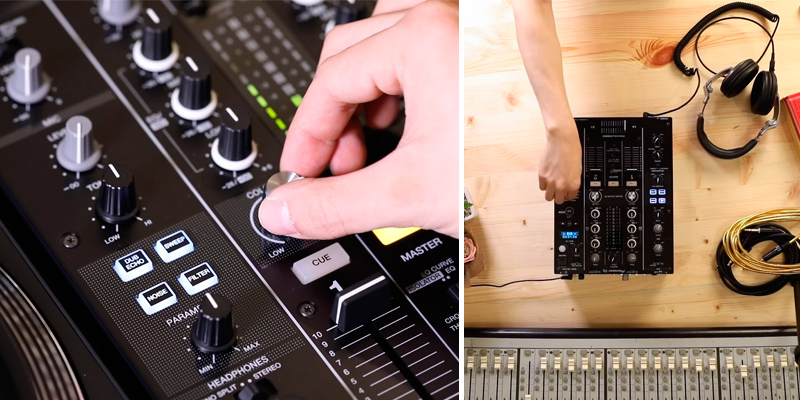
Premium Sound Quality
Even as you're switching between digital and analog sound sources, this model keeps the sound crisp and warm, with its 64-bit digital signal processor using dithering tech that eliminates noise and distortions. On a somewhat different note, the model also lets you use the integrated FX and the external FX from different apps simultaneously. Connect the phone/tablet via USB and engage the instrument and the FX app, there's nothing complicated here. Some might find the non-skid feet on this station a bit complicated though. There's something awkward about them, making the feet not quite as effective as they usually are.
But there's nothing awkward about the XLR terminal as well as the gold-plated RCAs, delivering premium sound quality on all connections. Likewise, the signal GND terminal lets you attach ground wires from analog turntables with relative ease.
Last but not least, the model will let you engage 8 different beat FX types (Delay, Pitch, Roll, Echo, Flanger, Reverb, Spiral, and Trans), synching them with the bpm. The alternative is the 4 sound color FX types (Noise, Filter, Sweep, and Dub Echo) that you can manipulate using the parameter control knob.
To give you the short version, the Pioneer DJM-450 is what aspiring/small-time DJs want and experienced/professional DJs need.

Additional Info
| Last updated price | $699.00 |
| Stock | In stock |
| ASIN | B01LYVE8KC |

Numark Scratch
Redefining Affordable Two-Channel Scratch Mixers
Numark Scratch is the company's scratchiest DJ mixer yet, so we'll allow the name this time. is With its 24-bit two-channel setup, this model redefines what affordable two-channel scratch mixers should be capable of. Using this one, you can create as well as perform at the highest level.
Everything starts with its all-metal build that incorporates professional features like an integrated Innofader crossfader, soft performance pads, instant loop encoder, and toggle paddles triggering software-based effects. Now, let's break these attributes down. To begin with, the performance pads are more responsive than before, giving you the tools you need to access cues, rolls, and samplers without delay. Using these pads, setting hot cue points, rolling temporary loops, and triggering samples become the easiest tasks.
Moving down the list, the model employs six dedicated software-based FXs (Delay, Echo, V. Echo, Reverb, Flanger, and Phaser). You can apply these FXs onto an individual channel or both via the upgraded performance base toggle paddles. You can also adjust the FX mix between Dry and Wet as you're feeling the mix.
Continuing with the theme, the Innofader crossfader that this DJ station integrates might impress even the most experienced turntablists, letting them perform intricate yet accurate scratches. They'll also be able to reverse the channels and change the slope, going from hard cuts to soft curves.
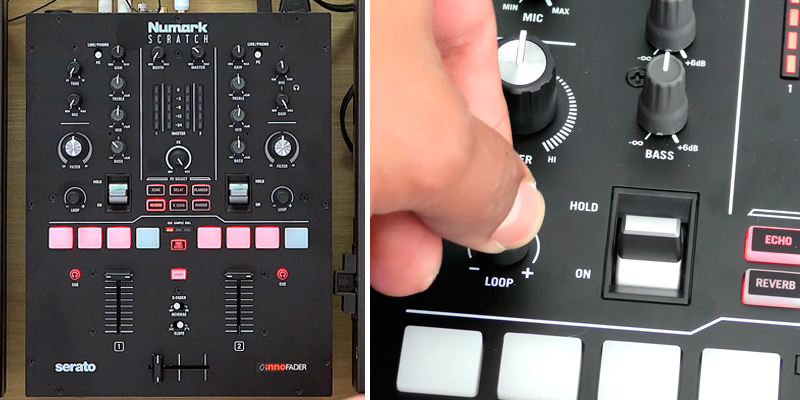
Instant Loop Encoder
As far as the affordable price category is concerned, DJ mixers seldom ensure excellent sound quality. This time, we're working with the opposite case. Owing to the model's 24-bit circuitry, the sound here is pristine. Switch between Serato DJ Pro or different preferred software, this one will not mind, even while playing vinyl records with a full EQ and dedicated low/high pass filters.
While not quite as sexy, the part that some DJs might find even more appealing than everything that we've outlined above is the instant loop encoder. Pressing down the encoder, you can keep the beat going, while the mixer lops to the default parameters that you set in the software. Turning the knob left or right will let you shorten the loop or extend the beat respectively.
The EQ could have used more work or thought put into it, that's the one problem we have with this model. Apart from that, the Numark Scratch will turn beginners into pros, withstanding the most rigorous routines and making mixing and scratching fun again.
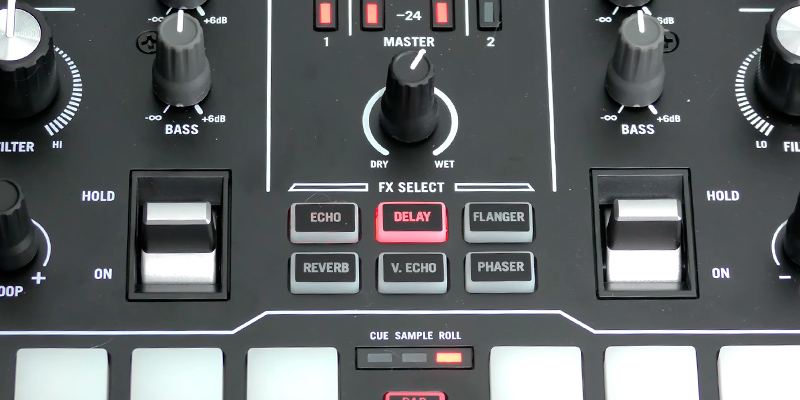
Additional Info
| Last updated price | $499.00 |
| Stock | In stock |
| ASIN | B07SNQXMLZ |

Behringer DJX750
Features Galore
The Behringer DJX750 means business. Measuring 14.6" x 12.6" x 4.1", this is not the most compact representative of DJ mixers, not quite. But, with its 5-channel ultra-low-noise setup and all-black housing, the model is an excellent representative of capable and stylish mixers. Merging intuitive controls with integrated digital effects, this unit enables clean and transparent processing that might just set different dance floors on fire.
The people behind this product are claiming that it is packing features galore and, considering the inexpensive price tag, we're inclined to agree with the statement. First things first, because the DJ's voice is his instrument, this station offers a dedicated mic channel that features a Talkover function. Automatically detecting the user's voice, this function ducks the track (brings down the music's volume), making sure that your voice's out front.
To add more, the onboard 3-band EQ will provide vocal fine-tuning, so you can boost or cut as much as 15 dB at low (80 Hz), mid (2.5 kHz), or high (12 kHz) frequency centers, keeping the tonal palette broad or tight when necessary. Contributing towards the same cause will also be the company's proprietary XPQ 3D stereo surround effect that will allow you to create a broad stereo image.
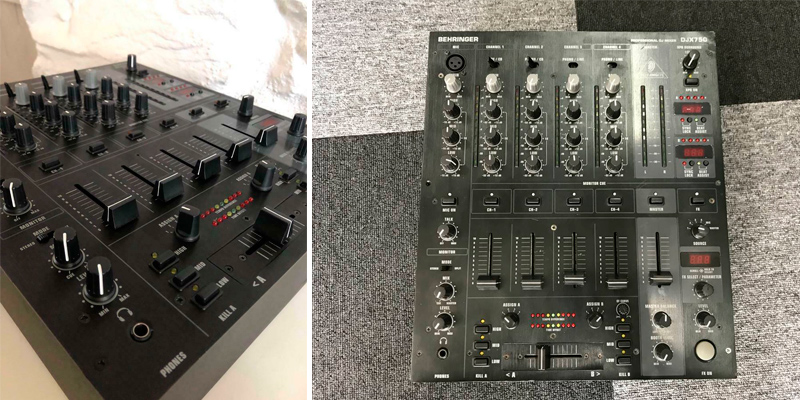
Mixing Anything that can be Clicked, Spun, or Spoken
As long as you can click, spin, or speak it, this model can mix it. Between the 2 dual-stereo phono/line channels, 1 phono/CD channel, and 1 line/CD channel, without even bringing up the aforementioned separate mic channel with a mic-on button and talk level control, this unit will let you work with every sound source in the book. But the more impressive part is that all of these channels come equipped with separate gain controls and 3-band EQs. Featuring full kill on channels 1 through 4, the model also provides 10-LED metering. Counting its multiple high-quality phono pre-amps, this unit can handle 3 turntables at the same time.
The UltraGlide™ faders are huge but there's nothing especially interesting about them. What is interesting though is the dual BPM counters with Sync Lock and Beat Assist features that this model integrates, making sure that the tracks always merge with seamless results.
Long story short, provided you're fine with the knobs being consistent (some are harder to turn than others), the Behringer DJX750 will not leave you disappointed, delivering features galore and letting you live large with more mediums.

Additional Info
| Last updated price | $374.99 |
| Stock | In stock |
| ASIN | B001RUEDI2 |

Numark M6 USB
Versatile Mixing with Computer Integration
The Numark M6 is not quite as cool as Scratch, something that even the folk behind this unit should be able to admit. That being said, there's also nothing uncool about this model. On the contrary, owing to the club-style design that this mixer's sporting, you can work not just with standard audio sources (not excluding turntables and CD players) but also with USB-enabled devices (primarily computers).
Pairing this station with Mac or PC via the USB port, you'll be able to mix in audio from different programs and record sets into just about any audio recording app. You can do that at home as well as on the road since the solid steel chassis since this adopts makes the station not just rugged but practically indestructible, meaning that you can go from clubs to mobile DJ systems without worrying that you might damage its circuitry or break the knobs. Size-wise, the model measures 12.625 x 14.25 x 4 (width x depth x height) inches, not necessarily different from most mid-range and low-end DJ mixers today. But the weight has been reduced, stopping at ~9.5 pounds and making the unit more portable than its direct competitors.
Looking at its features, this is not the most sophisticated mixer, we'll give you that, but the core controls are there. Between the 3-band EQs on each channel and the replaceable crossfader with slope control, this model gives you every essential tool you need to give the audience what they want. The cue buttons are on the small side, something that we would like to see improved next time. Aside from that, the layout is ergonomic and easy to navigate, with generous spacing between the buttons to minimize misclicking.
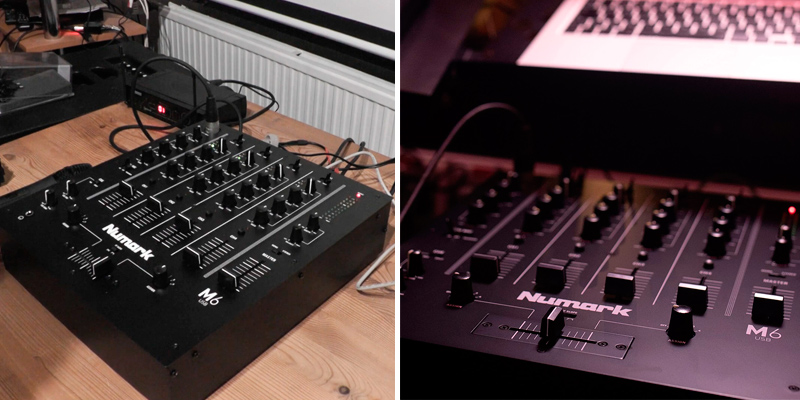
4-Channel DJ Mixer
DJs that do not jump on the mic from time to time can rarely keep the audience engaged throughout the entire set. To this end, the model lends an XLR input as well as a secondary 1/4-inch mic input. With these two, including the dedicated EQ band and gain controls, you can make announcements or easily squeeze impromptu vocal performances into the mix without any prep time. Even excluding these though, the input arsenal on the Numark M6 is nothing to sneeze at. Incorporating multiple phono/line switchable RCA inputs, this model will let you create without worrying that some audio source might prove incompatible with the unit.
All things considered, the Numark M6 covers the essentials and, with its USB port, enables PC/MAC integration, so you can work with whatever audio recording program you feel like working.

Additional Info
| Last updated price | $219.00 |
| Stock | In stock |
| ASIN | B0041206UW |

Behringer NOX101
Direction-Reverse and Adjustable Curve Control
The Behringer NOX101 is the least expensive and, as you would expect, the most basic model within this selection. What we're working with here is not something that will accommodate professional DJs. That being said, even the more demanding turntablists will appreciate the few but well-executed features that this unit's offering.
For starters, the model comes equipped with VCA-controlled cross and channel faders, ensuring noise-free audio and, with the company's signature UltraGlide™ tech, making the faders smooth. Still, despite the tech, some users might find them stiff, so this is not the part we'll vouch for. We can, however, vouch for the direction-reverse and adjustable curve control that the crossfader's employing, enabling versatile turntabling, while the above-mentioned UltraGlide™ makes sure that the faders survive at least 500,000 life cycles.
With its 2-channel setup, the model pretty much covers remixers and digital DJs. Even though the quantity might be lacking (when you start comparing this station with more expensive DJ mixers), the quality part does not disappoint. The 3-band EQs are pretty awesome, including the kill filters that the equalizers are adopting. But, from where we're standing, they're not quite as awesome as the premium phono pre-amp, delivering improved detail and ultimate punch.
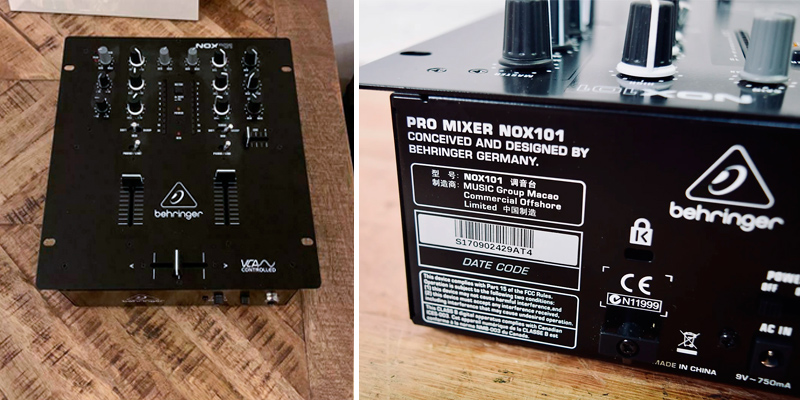
Brimming with Interfaces
Now that we've approached interfaces, removing the pre-amp from the equation, the biggest contributors here are the 2 phono/line inputs that come outfitted with individual gain controls. Can we say the same about the microphone input with XENYX mic pre-amp and 2-band tone control? Not quite, but almost. While not quite as rare, we can extend a similar sentiment towards the 10-segment level meters, enabling accurate and precise metering. Working alongside these two will be the gold-plated RCA connectors, keeping the signal integrity intact so that the audio that comes out, comes out flawless. Counting the extensive TRS and RCA outputs, the model enables flexible connectivity, while the channel 1/2 lets you work with a cue function.
Connections can get complicated. On the plus side, there's nothing complicated about the tough steel chassis that this DJ mixer's made from, so you can carry the unit around from wedding gigs to small venues without worrying that you might shorten its lifespan.
To give you the gist, small-timers that are fine with 2 channels and nonexistent integrated FXs will not go wrong choosing the Behringer NOX101 route.
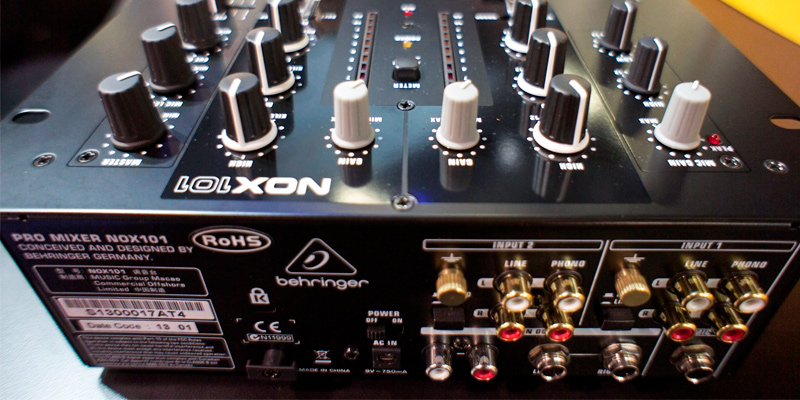
Additional Info
| Last updated price | $129.99 |
| Stock | In stock |
| ASIN | B00CTKI466 |
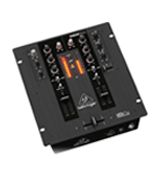
What Are DJ Mixers?
DJ mixers are audio mixing consoles that disc jockeys control and manipulate multiple audio signals with. Of course, you already know that. Chances are, you also already know what these consoles are made from, what they're using, and what are the differences between these mixers and DJ controllers (though we've outlined them below anyway). So, what's left is the difference between cheap mixers and good mixers.
What Features to Compare
Interfaces
Even the least expensive DJ mixers are usually endowed with quite a few interfaces. Looking at the back panel, you'll find inputs where you can plug turntables or CD players' aux cables. Next to these inputs, mixers put varying interfaces, including RCA, line/phono inputs, different microphone inputs, and USB. The microphone inputs can also include Talkover functions, allowing the DJ to speak through earphones. With these buttons, you can reduce the track's volume so that the audience can hear you clearly.
Channels
Mixers always come equipped with multiple channels. Sometimes two, sometimes as many as five. Each signal input is a separate channel, meaning that the left and right turntables will have individual channels. Nevertheless, every channel will have the same controls. These include gain and trim controls that let you manage separate input channels' levels.
Kill Switches
At times, DJ mixers come armed with kill switches. Using these switches, you can turn off the lows, mids, and highs. Pulling them down, you can also temporarily kill frequencies so that they come back up themselves.
Equalizers
Below the gain controls, you can usually find rotary kills represented by EQ knobs. With these knobs, you can control bass, treble, and midrange. Sometimes, these knobs control every channel but, more often than not, each channel will have a dedicated EQ knob.
Faders
Channel faders let you adjust individual channels' volume, while crossfaders enable fading one channel in and fading out the other one simultaneously. The models that feature so-called hamster switches will also allow you to reverse the crossfaders' position, so you can scratch with the same motion without worrying that you've already rotated the turntable.
Peak Meters
Peak meters are not complicated. In a nutshell, these meters indicate the channels' level or the master output. Having said that, there are also meters that can indicate clipping and multi-colored LEDs, letting the DJ know how close they are to clipping.
BPM Counters
The mixers that come equipped with BPM counters can measure and display separate sound files' BPM so that you can match them and ensure smooth transitions without guesswork.
Integrated Sound Effects
The more expensive models integrate different sound effects. With these FXs, you can feel the mix and make instant adjustments without relying upon third-party effects.
DJ Mixers vs DJ Controllers
Becoming a DJ is not just about talent, it is also about equipment. Without the right equipment, good luck harnessing that talent that you have. Generally speaking, the first step towards mastering this craft is figuring out DJ mixers and DJ controllers, learning the differences between the two and which one will suit you initially and long-term. So, let's get cracking, shall we?
DJ Controllers
DJ controllers incorporate 3 basic but fundamental parts: the control surface, audio interface, and the part that lets you work with smartphone/tablet apps. The control surface usually employs different knobs, buttons, faders/pads, jog wheels, you name them. Using these knobs, buttons, dials, wheels, and triggers, you manipulate the software that the controllers are relying upon. That said, the more expensive models might also include integrated screens and LEDs, indicating different parameters such as audio levels or system status. The audio interface is the part that transports the signal onto external equipment, including computers, laptops, smartphones, tablets, PA systems, effects processors, and more, depending on the connectors that the controllers come equipped with.
Using DJ controllers, DJs can access mixes and apply sound effects. Sure, you can manage the software interface with standard peripherals (mouse and keyboard) but the effort and effort required to do so will double or even triple. With these controllers, you have effective hardware that lets you configure the compatible software quickly and easily. Though there are controllers that are software specific, most are compatible with different programs. While the first group enables more powerful integration, you need to be sure that you're fine with the software these controllers are working with.
DJ Mixers
People confuse controllers and mixers primarily because the line between the two has become blurry with time. More controllers come equipped with mixers' features, while more and more mixers these days can work with different programs, both proprietary and third-party. More often than not, mixers give you improved connectivity and provide traditional surfaces, so you can mix without relying upon third-party software. But we've already established what makes/constitutes DJ mixers, so what's the biggest difference between the two? Well, controllers are using transport controls that let you manage the decks, volume, speed, and EQs. Meanwhile, DJ mixers rely upon dedicated mixing suites, taking inputs from record decks, CDs, or external soundcards attached to the device that runs the software. Professional DJs that want both sound quality and convenience usually go with mixers, while aspiring DJs normally start with DJ controllers before considering DJ mixers. Also, even the cheapest controllers can usually last a few years, whereas cheap mixers can seldom withstand frequent use, so you have to replace them at least every 2 years. So, assuming you have the financial means, we do not recommend trying the cheapest models - they're not worth it.
Popular Comparisons
































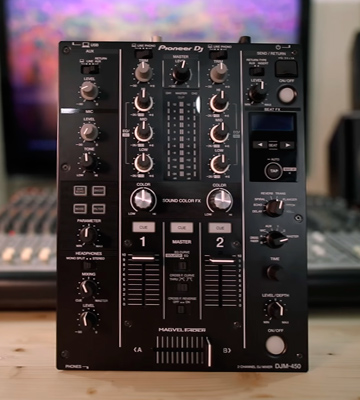

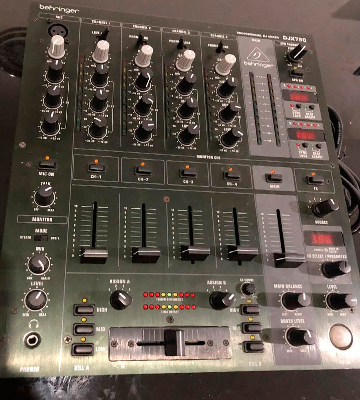

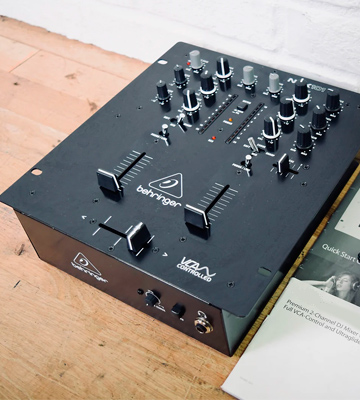
Your comment was successfully sent
Error! Please try again later